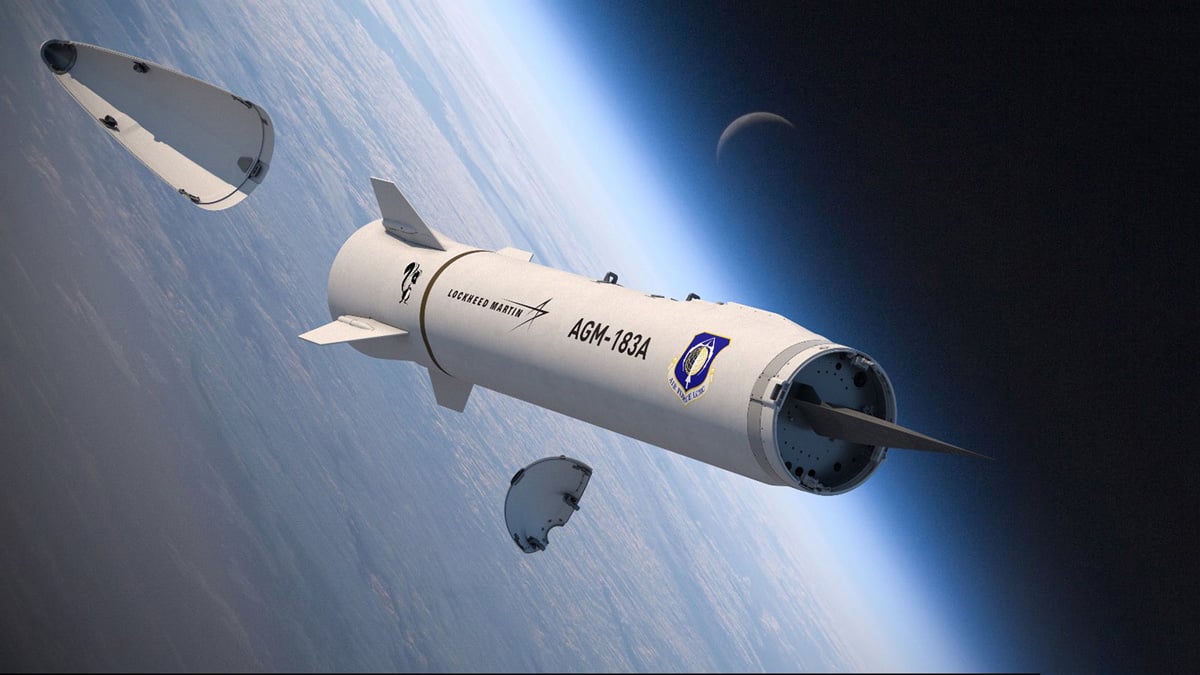Click Here to View This Page on Production Frontend
Click Here to Export Node Content
Click Here to View Printer-Friendly Version (Raw Backend)
Note: front-end display has links to styled print versions.
Content Node ID: 402250
Lockheed Martin’s AGM-183A Air-launched Rapid Response Weapon (ARRW, “Arrow”) successfully completed its final captive-carry test on August 8. The carrier aircraft was Boeing B-52H 60-0050—named ‘Dragon’s Inferno'—from the 419th Flight Test Squadron, which operated from the U.S. Air Force Test Center at Edwards AFB in California.
For the test, the B-52 was loaded with two representative ARRW Instrumented Measurement Vehicles (IMVs) carried in tandem under the port wing pylon. The forward missile of the pair was the principal trials subject, known as IMV-2. After flying a series of orbits to the north of Edwards, the B-52 transited to the Point Mugu Sea Range, south of the Channel Islands off the coast of southern California. From there IMV-2 transmitted positional and telemetry data to the range’s ground stations. System integration was also tested and launch profiles for the first flight test were practised. A flight test of the ARRW’s first-stage booster is expected before the end of the year.
“The event this week demonstrated the ability to communicate with the prototype weapon; the entire team is excited to take the next step and begin energetic flight test of our first air-launched hypersonic weapons,” said Lieutenant Colonel Michael Jungquist, 419th FLTS commander and Global Power Bomber Combined Test Force director. “These weapons will enable the application of conventional firepower anywhere in the world at eye-watering speed.”
Launched in answer to Chinese and Russian developments in the hypersonic weapon arena, ARRW is a rapid prototyping project that intends to field an operational weapon in the early 2020s, possibly as early as the fall of 2022 if continued development remains clear of obstacles. According to a June 2020 Government Accountability Office report on U.S. arms programs, the Air Force is acquiring four AGM-183As for live-fire tests, with the initial full-systems trial slated for October 2021. Four spares have also been ordered, which could become the first operational weapons if the four planned live launches are successful.
The U.S. Air Force has been pursuing both this weapon, which is based on the wedge-shaped Tactical Boost-Glide (TBG) concept from the Defense Advanced Research Projects Agency (DARPA), and an air-launched version of the conical-shaped Hypersonic Conventional Strike Weapon (HCSW) that is being developed for surface-launched applications for the Army and Navy. The Air Force has decided to concentrate initially on the smaller ARRW but has not ruled out a version of HCSW in the future.
Lockheed Martin is the prime on both weapons, with its Space division handling the HCSW development while ARRW is managed by the Missiles and Fire Control business unit. Development of ARRW began in 2018, and two captive-carry trials were undertaken previously, both involving the IMV-1 test item carried by a B-52H. The first was conducted from Edwards on June 12, 2019.
ARRW’s TBG concept involves the missile being accelerated to hypersonic speed and high altitude by a first-stage solid-fuel rocket section, which has folding fins to reduce its dimensions for carriage. The weapon vehicle itself is released following the jettison of the booster’s aerodynamic nosecone. The unpowered wedge-shaped effector then glides to its target at great speed. No details regarding range or speed performance have been released, but a range of considerably above 1,000 miles is likely, while speed will be above Mach 7. DARPA has hinted that speeds of up to Mach 20 are achievable with its TBG concept.
In service, the B-52H is the lead platform for carrying the AGM-183A, but the weapon’s size would permit it to be launched from the centerline pylon of the Boeing F-15EX. The Air Force has also voiced the possibility of reactivating external hardpoints on the Boeing B-1B bomber to carry ARRWs. By using both external carriage and internal rotary launchers, a B-1 could carry a theoretical maximum of 31 AGM-183A missiles.
